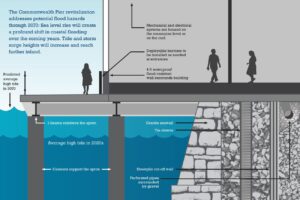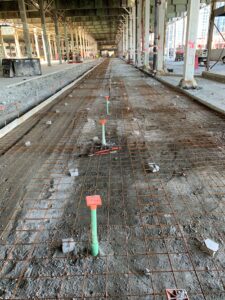Protecting a Historic Pier
in South Boston
(awaiting installation)
The Commonwealth Pier revitalization addresses potential flood hazards through 2070: Sea level rise will create a profound shift in coastal flooding over coming years. Tide and storm surge heights will increase and reach further inland.
Illustration by Karen Stein Shanley
As a vital component of Commonwealth Pier’s 2020 – 2025 renovation, engineers and architects prepared the pier and building for extreme weather caused by climate change.
AMONG THE DEFENSES:
To counter uplift forces during extreme high tides:
- More than 300 structural tie-downs are anchored 90 feet deep and connected to the ground floor of the building.
- Excess water will be collected by a network of pipes below the building and released into the harbor when the tide falls.
To protect against flooding:
- A steel sheet pile wall is located inside the seawall to protect against rising seawater entering from beneath the building.
- A 4-foot waterproof wall is concealed within the building’s perimeter.
- Deployable barriers are available for all building entrances.
- Should water breach these defenses, all mechanical and electrical systems are housed on the mezzanine level or on the roof.
Commonwealth Pier is designed to withstand destructive storms until about 2070. However, we need to act swiftly to reduce carbon emission to prevent the worst effects of a warming planet.
Structural tie-downs made of concrete- encapsulated steel were driven deep below the pier to prevent uplift. This photo shows the concrete slab that was poured on top of the tie-downs. The plates are secured to the top side of the slab, preventing any buoyancy or movement upwards.
Courtesy of Pembroke
The Seaport neighborhood—built on man-made land—is at risk from severe coastal storms. New construction along Boston’s waterfront requires buildings be set back to both create public access and to protect buildings from flooding. To the west of Commonwealth Pier, these setbacks are in place at Fan Pier and Pier 4. However, Commonwealth Pier was constructed more than a century ago to serve cargo and passenger ships docked alongside. This Boston landmark is especially vulnerable hence the extensive resiliency measures.
Photo by Kyle Klein
Sign Location
More ...
Resources
All the information for this sign was provided by engineers and architects working for Pembroke.
Acknowledgments
- Our gratitude to the Perkins School for the Blind for their partnership in creating the audio files.




